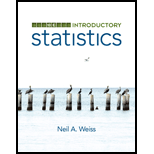
Concept explainers
SELF-PERCEPTION AND PHYSICAL ACTIVITY
As you learned at the beginning of this chapter, Z, Veselska et al. explored connections between aspects of self-perception and physical activity among adolescents. The study involved a sample of adolescents from the Slovak and Czech Republics with ages
The youths sampled completed several self-perception questionnaires and also answered a question about their physical activity. The respondents were divided into three physical-activity categories: no physical activity (none), infrequent physical activity (infrequent), and everyday physical activity (everyday). Summary statistics for the researchers1 findings for boys and girls separately are presented in the table on page 699.
First consider self-liking.
- a. Assuming that self-liking scores for boys are approximately
normally distributed in each physical-activity category, can we reasonably presume that the conditions for performing a one-way ANOVA are met? (Hint: Rule of 2) - b. Perform a one-way ANOVA to decide, at the 5% significance level, whether the data provide sufficient evidence to conclude that a difference exists in
mean self-liking scores among adolescent boys in the three physical-activity categories. Interpret your result. - c. If appropriate, conduct a Tukey multiple comparison of the three mean sell-liking scores and interpret your results. Use a family confidence level of 0.95.
- d. Repeat parts (a)-(c) for girls.
- 1. Next consider self-competence.
- e. Assuming that self-competence scores for boys are approximately normally distributed in each physical-activity category, can we reasonably presume that the conditions for performing a one-way AN OVA are met?
- f. Perform a one-way ANOVA to decide, at the 5% significance level, whether the data provide sufficient evidence to conclude that a difference exists in mean sell-competence scores among adolescent boys in the three physical-activity categories. Interpret your result.
- g. If appropriate, conduct a Tukey multiple comparison of the three mean self-competence scores and interpret your results. Use a family confidence level of 0.95.
- h. Repeat parts (e)-(g) for girls.
Now select any one of the remaining aspects-of self categories and repeal parts (a)-(d).

Want to see the full answer?
Check out a sample textbook solution
Chapter 16 Solutions
Introductory Statistics (10th Edition)
 Glencoe Algebra 1, Student Edition, 9780079039897...AlgebraISBN:9780079039897Author:CarterPublisher:McGraw Hill
Glencoe Algebra 1, Student Edition, 9780079039897...AlgebraISBN:9780079039897Author:CarterPublisher:McGraw Hill Holt Mcdougal Larson Pre-algebra: Student Edition...AlgebraISBN:9780547587776Author:HOLT MCDOUGALPublisher:HOLT MCDOUGAL
Holt Mcdougal Larson Pre-algebra: Student Edition...AlgebraISBN:9780547587776Author:HOLT MCDOUGALPublisher:HOLT MCDOUGAL Big Ideas Math A Bridge To Success Algebra 1: Stu...AlgebraISBN:9781680331141Author:HOUGHTON MIFFLIN HARCOURTPublisher:Houghton Mifflin Harcourt
Big Ideas Math A Bridge To Success Algebra 1: Stu...AlgebraISBN:9781680331141Author:HOUGHTON MIFFLIN HARCOURTPublisher:Houghton Mifflin Harcourt College Algebra (MindTap Course List)AlgebraISBN:9781305652231Author:R. David Gustafson, Jeff HughesPublisher:Cengage Learning
College Algebra (MindTap Course List)AlgebraISBN:9781305652231Author:R. David Gustafson, Jeff HughesPublisher:Cengage Learning



